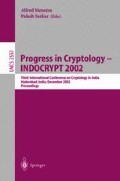Abstract
In the purchase with electronic money customers are sometimes required to spend multiple electronic coins at a time. In case of physical coins a customer simply grabs multiple coins and hands them out to a merchant. Likewise, the customer spends multiple electronic coins just by giving all coins to the merchant. However, we can expect one step further in the electronic coins. There is room to create a combined coin from multiple coins. If the combining leads to an efficient spending, the customer as well as the merchant and the bank can get benefit of the reduction of cost. There is a proposal by Chaum for the combining operation in the online cash, but no method has been proposed for offline coins up to now. Thus we seek a way to spend offline electronic coins in a combined form without assistance of an issuing bank. The combining reduces either computational complexity associated with the spending or communication complexity between the customer and the merchant. We propose a method to achieve combining capability in the Eng-Okamoto offline divisible electronic cash, and show that (2n - 2)|p| - (n - 1)|q| bits of the message length can be reduced in the combining of n coins under the parameter of moduli p and q satisfying q|p-1. If preliminary computation is allowed, the verification cost is also slightly reduced. Significantly, even after combining coins, the bank can identify overspenders.
Access this chapter
Tax calculation will be finalised at checkout
Purchases are for personal use only
Preview
Unable to display preview. Download preview PDF.
References
M. Bellare, J.A. Garay and T. Rabin, “Fast Batch Veri.cation for Modular Exponentiation and Digital Signatures,” K. Nyberg (Eds.), Advances in Cryptology-EUROCRYPT’ 98, Lecture Notes in Computer Science 1403, Springer-Verlag, pp.236–250 (1998).
C. Boyd and C. Pavlovski, “Attacking and Repairing Batch erification Schemes,” T. Okamoto. (Ed.), Advances in Cryptology-ASIACRYPT 2000, Lecture Notes in Computer Science 1976, Springer-Verlag, pp.58–71 (2000).
S. Brands, “Untraceable Off-line Cash in Wallet with Observers,” D. R. Stinson (Ed.), Advances in Cryptology-CRYPTO’ 93, Lecture Notes in Computer Science 773, Springer-Verlag, pp.302–318 (1994).
D. Chaum, “Online Cash Checks,” J.-J. Quisquater and J. Vandewalle (Eds.), Advances in Cryptology-EUROCRYPT’ 89, Lecture Notes in Computer Science 434, Springer-Verlag, pp.288–293 (1990).
E. CHIDA, M. MAMBO, H. SHIZUYA, “Digital Money-A Survey,” Interdisciplinary Information Sciences, Vol.7, No.2, pp.135–165 (2001).
T. Eng and T. Okamoto, “Single-TermD ivisible Electronic Coins,” A. De Santis (Ed.), Advances in Cryptology-EUROCRYPT’ 94, Lecture Notes in Computer Science 950, Springer-Verlag, pp.306–319 (1995).
T. Okamoto, “Provable secure and practical identification schemes and corresponding signature schemes,” E. F. Brickell, (Ed.), Advances in Cryptology-CRYPTO’ 92, Lecture Notes in Computer Science 740, Springer-Verlag, pp.31–53 (1993).
T. Okamoto, “An Efficient Divisible Electronic Cash Scheme,” D. Coppersmith (Ed.), Advances in Cryptology-CRYPTO’ 95, Lecture Notes in Computer Science 963, Springer-Verlag, pp.438–451 (1995).
C. Pavlovski, C. Boyd and E. Foo, “Detachable Electronic Coins,” V. Varadharajan and Y. Mu (Eds.), Information and Communication Security, ICICS’99, Lecture Notes in Computer Science 1726, Springer-Verlag, pp.54–70 (1999).
Author information
Authors and Affiliations
Editor information
Editors and Affiliations
Rights and permissions
Copyright information
© 2002 Springer-Verlag Berlin Heidelberg
About this paper
Cite this paper
Chida, E., Kasai, Y., Mambo, M., Shizuya, H. (2002). Spending Offline Divisible Coins with Combining Capability. In: Menezes, A., Sarkar, P. (eds) Progress in Cryptology — INDOCRYPT 2002. INDOCRYPT 2002. Lecture Notes in Computer Science, vol 2551. Springer, Berlin, Heidelberg. https://doi.org/10.1007/3-540-36231-2_27
Download citation
DOI: https://doi.org/10.1007/3-540-36231-2_27
Published:
Publisher Name: Springer, Berlin, Heidelberg
Print ISBN: 978-3-540-00263-5
Online ISBN: 978-3-540-36231-9
eBook Packages: Springer Book Archive

